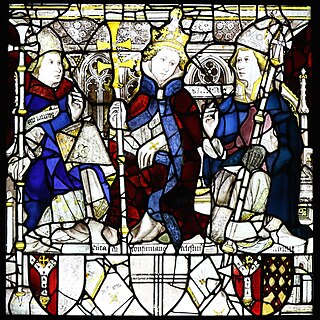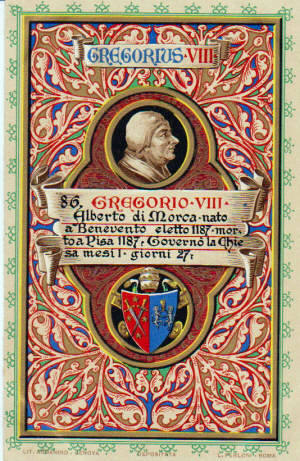Sources
- Gregorovius, Ferdinand. Rome in the Middle Ages Vol. IV Part 2. trans. Annie Hamilton. 1905.
Rudolf (also Rudolph or Rodolf, Italian Rodolfo) was the papal rector of the Duchy of Benevento under Pope Leo IX from 1053 to 1054.
Rudolf was a Swabian captain who led that contingent of forces at the Battle of Civitate. His men were routed by Richard I of Aversa. Rudolf was made rector of Benevento after the pope concluded a treaty with the Normans. Rudolf did not hold his post for very long; the fickle Beneventans recalled their old princes, whom they had once expelled, Pandulf III and Landulf VI.

Pope Honorius II, born Lamberto Scannabecchi, was head of the Catholic Church and ruler of the Papal States from 21 December 1124 to his death in 1130.

Pope Celestine II, born Guido di Castello, was head of the Catholic Church and ruler of the Papal States from 26 September 1143 to his death in 1144.

Pope Gregory VIII, born Alberto di Morra, was head of the Catholic Church and ruler of the Papal States for two months in 1187. Becoming Pope after a long diplomatic career as Apostolic Chancellor, he was notable in his brief reign for reconciling the Papacy with the estranged Holy Roman Empire and for initiating the Third Crusade.

Pope Lucius II, born Gherardo Caccianemici dal Orso, was head of the Catholic Church and ruler of the Papal States from 9 March 1144 to his death in 1145. His pontificate was notable for the unrest in Rome associated with the Commune of Rome and its attempts to wrest control of the city from the papacy. He supported Empress Matilda's claim to England in the Anarchy, and had a tense relationship with King Roger II of Sicily.
Pope Paul I was the bishop of Rome and ruler of the emerging Papal States from 29 May 757 to his death. He first served as a Roman deacon and was frequently employed by his brother, Pope Stephen II, in negotiations with the Lombard kings.

Benevento is a city and comune of Campania, Italy, capital of the province of Benevento, 50 kilometres (31 mi) northeast of Naples. It is situated on a hill 130 metres above sea level at the confluence of the Calore Irpino and the Sabato. In 2020, Benevento has 58,418 inhabitants. It is also the seat of a Catholic archbishop.

Gerard, also known as Gerard the Wonderful, was a Lotharingian nobleman. He was the count of Metz and Châtenois from 1047 to 1048, when his brother Duke Adalbert resigned them to him upon his becoming the Duke of Upper Lorraine. On Adalbert's death the next year, Gerard became duke, a position that he held until his death. In contemporary documents, he is called Gerard of Alsace, Gerard of Chatenoy, or Gerard of Flanders.

The Duchy of Benevento was the southernmost Lombard duchy in the Italian Peninsula that was centred on Benevento, a city in Southern Italy. Lombard dukes ruled Benevento from 571 to 1077, when it was conquered by the Normans for four years before it was given to the Pope. Being cut off from the rest of the Lombard possessions by the papal Duchy of Rome, Benevento was practically independent from the start. Only during the reigns of Grimoald and the kings from Liutprand on was the duchy closely tied to the Kingdom of the Lombards. After the fall of the kingdom in 774, the duchy became the sole Lombard territory which continued to exist as a rump state, maintaining its de facto independence for nearly 300 years, although it was divided after 849. Benevento dwindled in size in the early 11th century, and was completely captured by the Norman Robert Guiscard in 1053.
The Patrimony of Saint Peter originally designated the landed possessions and revenues of various kinds that belonged to the apostolic Holy See. Until the middle of the 8th century this consisted wholly of private property; later, it corresponded to the territories under Papal sovereignty, but from the early 13th century the term was applied to one of the four provinces of the States of the Church.

The Principality of Capua was a Lombard state centred on Capua in Southern Italy. Towards the end of the 10th century the Principality reached its apogee, occupying most of the Terra di Lavoro area. It was originally a gastaldate, then a county, within the principality of Salerno.

The Archdiocese of Benevento is a Latin archdiocese of the Catholic Church. It currently has five suffragan dioceses: the diocese of Ariano Irpino-Lacedonia, the diocese of Avellino, the diocese of Cerreto Sannita-Telese-Sant'Agata de' Goti, the Territorial Abbey of Montevergine, and the archdiocese of Sant'Angelo dei Lombardi-Conza-Nusco-Bisaccia.
Landulf II was the Archbishop of Benevento from 8 November 1108 to his death. He succeeded Roffredo more than a year after the latter's death on 9 September 1107. The main source for his eventful reign is the contemporary chronicler and fellow Lombard and Benventan Falco.

The Norman conquest of southern Italy lasted from 999 to 1194, involving many battles and independent conquerors.
Pandulf of Pisa was a twelfth-century Italian cardinal, and biographer of several contemporary popes. He was a native of Rome. He was a nephew of Cardinal Hugo of Alatri. Under Pope Paschal II, and probably with the patronage of his uncle, Pandulf held the post of ostiarius at the papal court. It is deduced from his detailed description of the election of Pope Gelasius II on 24 January 1118 that he was present. On his coronation day, 10 March 1118, Pope Gelasius II elevated him to the rank of Lector and Exorcist. Pope Calixtus II ordained him a subdeacon.
Romuald was the cardinal-deacon of Santa Maria in Via Lata from about 1109, and the Archbishop of Salerno from 1121 until his death.

Rocca dei Rettori is a castle in Benevento, southern Italy. It currently houses the Museum of the Samnium.
Alessandro di Sangro was a Roman Catholic prelate who served as Archbishop of Benevento (1616–1633) and Titular Patriarch of Alexandria (1604–1633)

Andrea Mugione was an Italian Catholic bishop. He has previously served as Bishop of Cassano all'Jonio from 1988 to 1998, Archbishop of Crotone-Santa Severina from 1998 to 2006, and Metropolitan Archbishop of Benevento from 2006 to 2016.
Roscemanno, O.S.B.Cas. was a Roman Catholic Cardinal and Deacon of San Giorgio in Velabro.